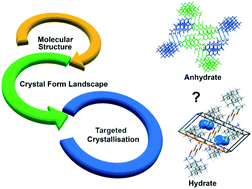当前位置:
X-MOL 学术
›
CrystEngComm
›
论文详情
Our official English website, www.x-mol.net, welcomes your feedback! (Note: you will need to create a separate account there.)
From serendipity to supramolecular design: assessing the utility of computed crystal form landscapes in inferring the risks of crystal hydration in carboxylic acids†
CrystEngComm ( IF 3.1 ) Pub Date : 2018-06-22 00:00:00 , DOI: 10.1039/c8ce00758f Sharmarke Mohamed 1, 2, 3, 4 , Liang Li 3, 4, 5, 6
CrystEngComm ( IF 3.1 ) Pub Date : 2018-06-22 00:00:00 , DOI: 10.1039/c8ce00758f Sharmarke Mohamed 1, 2, 3, 4 , Liang Li 3, 4, 5, 6
Affiliation

|
A set of calculated structural descriptors [% solvent accessible volumes per unit cell (% SAVs), the relative packing index and the estimated distance of polar/non-polar groups on the acid relative to the lattice positions corresponding to crystal voids] were used to assess the utility of predicted crystal form landscapes (CFLs) in warning against the risks of crystal hydration using model carboxylic acids that are known to crystallise as anhydrate, monohydrate and dihydrate crystal phases, respectively. The crystal structures of 1-adamantaneacetic acid and 3-bromoadamantane-1-acetic acid are reported as anhydrates following crystallisation screens for possible hydrates of both. The results show that % SAVs are a poor predictor of crystal hydration as the majority of the predicted anhydrate polymorphs (up to a relative lattice energy range of 10 kJ mol−1) for all systems did not display packings with solvent accessible voids. The relative packing index (ΔPI) of the known hydrates and the set of low energy predicted anhydrate polymorphs was found to be a useful predictor of crystal packing frustration. 4-Oxocyclohexanecarboxylic acid which crystallises as a monohydrate (INOGEX) displayed a CFL where 86% of the predicted anhydrate polymorphs within a relative lattice energy range of 10 kJ mol−1 displayed poorer crystal packings than the monohydrate. By contrast, in 2-pyrone-4,6-dicarboxylic acid which crystallises as a dihydrate (KISJEC), only 15% of predicted anhydrate polymorphs had a lower packing efficiency than the dihydrate, indicating that the crystal hydration for this system is not driven by poor crystal packing of the acid. Careful inspection of the hydrogen bond motifs adopted by the predicted anhydrate polymorphs has shown that crystal hydration in 2-pyrone-4,6-dicarboxylic acid may be driven by the need to satisfy all hydrogen bond donor/acceptor groups on the acid whilst in 4-oxocyclohexanecarboxylic acid, water inclusion is likely to be driven by poor crystal packing of the low energy anhydrate polymorphs for this molecule. The results suggest that careful analysis of the packing efficiencies and the lattice positions of the crystal voids in predicted anhydrate polymorphs can provide clues to the driving force for crystal hydration as well as the types of intermolecular acid–water interactions that may be observed in hydrated crystal forms.
中文翻译:

从偶然性到超分子设计:评估计算的晶体形态在推断羧酸晶体水化风险中的效用†
一组计算的结构描述符[每单位晶格的溶剂可到达体积百分比(%SAVs),相对堆积指数以及酸上极性/非极性基团相对于对应于晶体空隙的晶格位置的估计距离)用于使用已知分别结晶为无水,一水合物和二水合物结晶相的模型羧酸,评估预测的晶型态(CFL)在警告晶体水化风险方面的实用性。在结晶筛选两种可能的水合物之后,报道了1-金刚烷乙酸和3-溴金刚烷-1-乙酸的晶体结构为无水物。-1)对于所有系统,未显示有溶剂可触及空隙的填料。发现已知水合物的相对堆积指数(ΔPI)和一组低能预测的无水多晶型物是预测晶体堆积失意的有用指标。一水合物结晶的4-氧代环己烷甲酸(INOGEX)显示出CFL,其中在10 kJ mol -1的相对晶格能范围内,有86%的预测无水多晶型物显示出比一水合物差的晶体堆积。相比之下,在结晶为二水合物的2-吡喃基4,6-二羧酸(KISJEC)中,只有15%的预测无水多晶型物的填充效率低于二水合物,表明该系统的晶体水合没有被驱动酸的晶体堆积不良。仔细检查了预测的无水多晶型物所采用的氢键基序,结果表明,2-吡喃酮4,6-二羧酸中的晶体水合作用可能是由满足酸中所有氢键供体/受体基团的需要驱动的,而在4 -氧代环己烷甲酸,水的夹杂物很可能是由于该分子的低能无水多晶型物的不良晶体堆积而驱动的。
更新日期:2018-06-22
中文翻译:

从偶然性到超分子设计:评估计算的晶体形态在推断羧酸晶体水化风险中的效用†
一组计算的结构描述符[每单位晶格的溶剂可到达体积百分比(%SAVs),相对堆积指数以及酸上极性/非极性基团相对于对应于晶体空隙的晶格位置的估计距离)用于使用已知分别结晶为无水,一水合物和二水合物结晶相的模型羧酸,评估预测的晶型态(CFL)在警告晶体水化风险方面的实用性。在结晶筛选两种可能的水合物之后,报道了1-金刚烷乙酸和3-溴金刚烷-1-乙酸的晶体结构为无水物。-1)对于所有系统,未显示有溶剂可触及空隙的填料。发现已知水合物的相对堆积指数(ΔPI)和一组低能预测的无水多晶型物是预测晶体堆积失意的有用指标。一水合物结晶的4-氧代环己烷甲酸(INOGEX)显示出CFL,其中在10 kJ mol -1的相对晶格能范围内,有86%的预测无水多晶型物显示出比一水合物差的晶体堆积。相比之下,在结晶为二水合物的2-吡喃基4,6-二羧酸(KISJEC)中,只有15%的预测无水多晶型物的填充效率低于二水合物,表明该系统的晶体水合没有被驱动酸的晶体堆积不良。仔细检查了预测的无水多晶型物所采用的氢键基序,结果表明,2-吡喃酮4,6-二羧酸中的晶体水合作用可能是由满足酸中所有氢键供体/受体基团的需要驱动的,而在4 -氧代环己烷甲酸,水的夹杂物很可能是由于该分子的低能无水多晶型物的不良晶体堆积而驱动的。



























 京公网安备 11010802027423号
京公网安备 11010802027423号